Solar eclipse of December 14, 2020
A total solar eclipse will occur on December 14, 2020. A solar eclipse occurs when the Moon passes between Earth and the Sun, thereby totally or partly obscuring the image of the Sun for a viewer on Earth. A total solar eclipse occurs when the Moon's apparent diameter is larger than the Sun's, blocking all direct sunlight, turning day into darkness. Totality occurs in a narrow path across Earth's surface, with the partial solar eclipse visible over a surrounding region thousands of kilometres wide. The Moon’s apparent diameter will be larger because the Moon occurs only 1.8 days after perigee (Perigee on December 12, 2020).
| Solar eclipse of December 14, 2020 | |
|---|---|
 Map | |
| Type of eclipse | |
| Nature | Total |
| Gamma | -0.2939 |
| Magnitude | 1.0254 |
| Maximum eclipse | |
| Duration | 130 sec (2 m 10 s) |
| Coordinates | 40.3°S 67.9°W |
| Max. width of band | 90 km (56 mi) |
| Times (UTC) | |
| Greatest eclipse | 16:14:39 |
| References | |
| Saros | 142 (23 of 72) |
| Catalog # (SE5000) | 9554 |
The path is similar to the solar eclipse of February 26, 2017. It takes place just 17 months after the solar eclipse of July 2, 2019 and, like the 2019 eclipse, is also visible from Chile and Argentina. It is also a partial solar eclipse in Bolivia, Brazil, Ecuador, Paraguay, Peru and Uruguay.
This solar eclipse will occur one lunar year after the annular solar eclipse on December 26, 2019.
Visibility
Chile
Totality will be visible in portions of Araucanía Region, Los Ríos Region, and a very small part of Bío Bío Region. Cities in the path include Temuco, Villarrica, and Pucón. Totality will also be visible on Mocha Island.
Argentina
Totality will also be visible across the Northern Patagonia Region (specifically the provinces of Neuquén and Río Negro), passing through cities including Piedra del Águila, Sierra Colorada, Ministro Ramos Mexía, Junín de los Andes, and partially in San Martín de los Andes and San Carlos de Bariloche.
Images
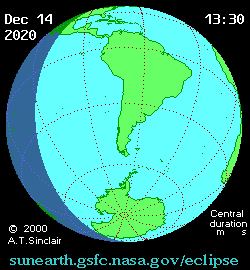
Animated path
Related eclipses
Eclipses of 2020
Half-Saros cycle
- Preceded: Lunar eclipse of December 10, 2011
- Followed: Lunar eclipse of December 20, 2029
Solar Saros 142
- Preceded: Solar eclipse of December 4, 2002
- Followed: Solar eclipse of December 26, 2038
Solar eclipses of 2018–2021
This eclipse is a member of a semester series. An eclipse in a semester series of solar eclipses repeats approximately every 177 days and 4 hours (a semester) at alternating nodes of the Moon's orbit.[1]
Note: Partial solar eclipses on February 15, 2018, and August 11, 2018, occurred during the previous semester series.
| Solar eclipse series sets from 2018–2021 | ||||||
|---|---|---|---|---|---|---|
| Ascending node | Descending node | |||||
| Saros | Map | Gamma | Saros | Map | Gamma | |
| 107 | 2017 July 23 | -2.14244 | 112 | 2018 January 17 | 1.78677 | |
117.jpg) Partial from Melbourne, Australia | 2018 July 13 Partial |
-1.35423 | 122 Partial from Nakhodka, Russia | 2019 January 6 Partial |
1.14174 | |
127 La Serena, Chile | 2019 July 2 Total |
-0.64656 | 132.jpg) Jaffna, Sri Lanka | 2019 December 26 Annular |
0.41351 | |
137 Beigang, Yunlin, Taiwan | 2020 June 21 Annular |
0.12090 | 142 | 2020 December 14 Total |
-0.29394 | |
| 147 | 2021 June 10 Annular |
0.91516 | 152 | 2021 December 4 Total |
-0.95261 | |
| 157 | 2022 May 30 | 1.65174 | 162 | 2022 November 23 | -1.69875 | |
Saros 142
It is a part of Saros cycle 142, repeating every 18 years, 11 days, containing 72 events. The series started with partial solar eclipse on April 17, 1624. It contains one hybrid eclipse on July 14, 1768, and total eclipses from July 25, 1786 through October 29, 2543. The series ends at member 72 as a partial eclipse on June 5, 2904. The longest duration of totality will be 6 minutes, 34 seconds on May 28, 2291. All eclipses in this series occurs at the Moon’s descending node.[2]
| Series members 17–41 occur between 1901 and 2359 | ||
|---|---|---|
| 17 | 18 | 19 |
 October 10, 1912 |
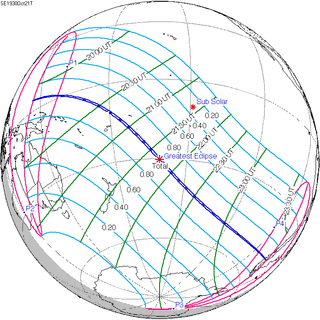 October 21, 1930 |
 November 1, 1948 |
| 20 | 21 | 22 |
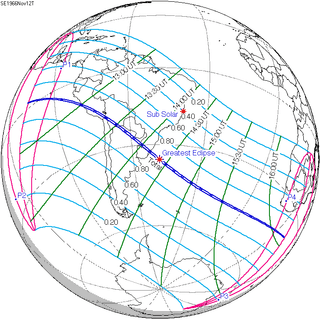 November 12, 1966 |
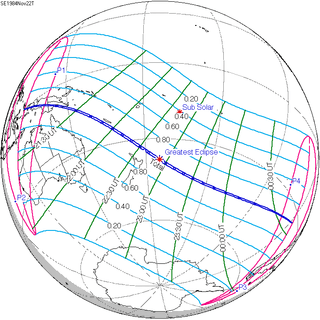 November 22, 1984 |
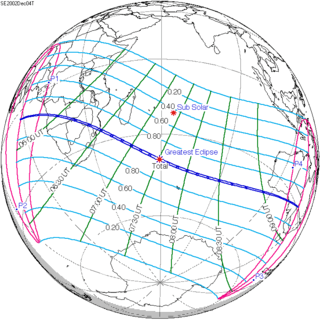 December 4, 2002 |
| 23 | 24 | 25 |
 December 14, 2020 |
 December 26, 2038 |
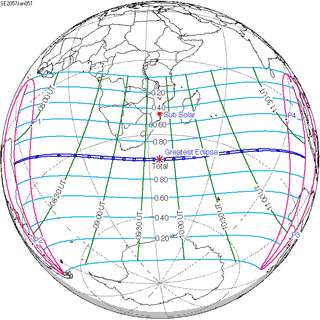 January 5, 2057 |
| 26 | 27 | 28 |
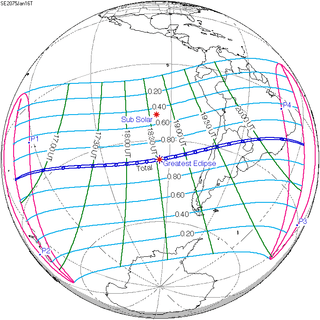 January 16, 2075 |
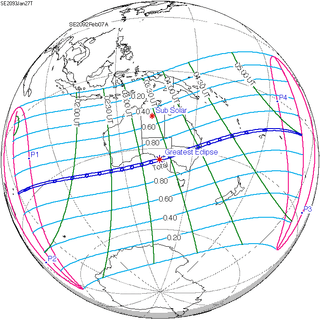 January 27, 2093 |
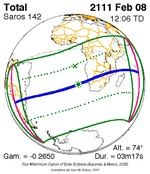 February 8, 2111 |
| 29 | 30 | 31 |
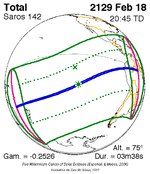 February 18, 2129 |
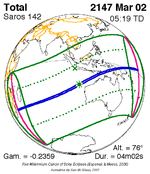 March 2, 2147 |
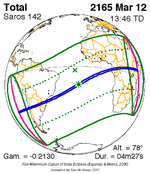 March 12, 2165 |
| 32 | 33 | 34 |
 March 23, 2183 |
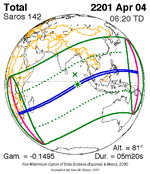 April 4, 2201 |
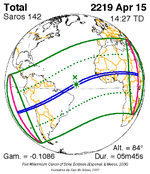 April 15, 2219 |
| 35 | 36 | 37 |
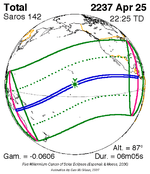 April 25, 2237 |
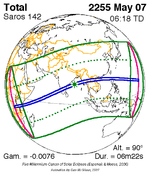 May 7, 2255 |
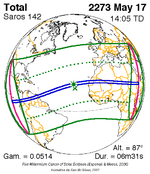 May 17, 2273 |
| 38 | 39 | 40 |
 May 28, 2291 |
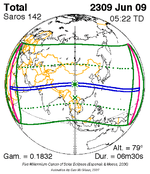 June 9, 2309 |
 June 20, 2327 |
| 41 | ||
 June 30, 2345 | ||
Metonic cycle
The metonic series repeats eclipses every 19 years (6939.69 days), lasting about 5 cycles. Eclipses occur in nearly the same calendar date. In addition, the octon subseries repeats 1/5 of that or every 3.8 years (1387.94 days). All eclipses in this table occur at the Moon's descending node.
| 21 events between July 22, 1971 and July 22, 2047 | ||||
|---|---|---|---|---|
| July 21–22 | May 9–11 | February 26–27 | December 14–15 | October 2–3 |
| 106 | 108 | 110 | 112 | 114 |
| July 21, 1952 | May 10, 1956 | February 26, 1960 | December 16, 1963 | October 3, 1967 |
| 116 | 118 | 120 | 122 | 124 |
 July 22, 1971 |
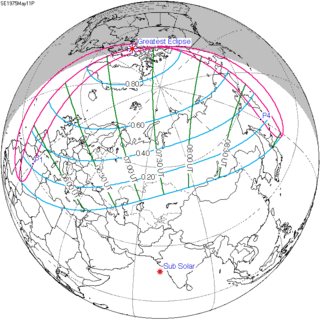 May 11, 1975 |
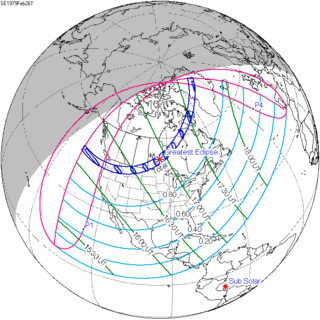 February 26, 1979 |
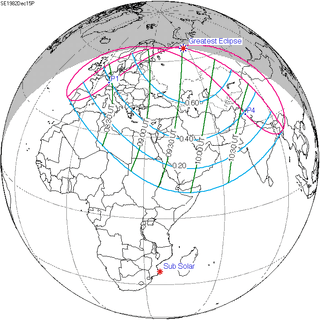 December 15, 1982 |
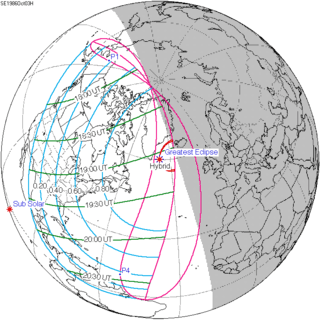 October 3, 1986 |
| 126 | 128 | 130 | 132 | 134 |
 July 22, 1990 |
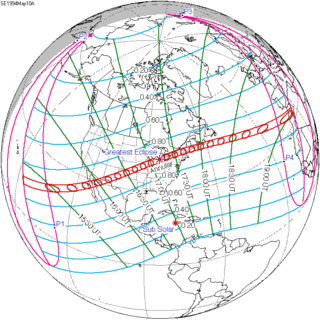 May 10, 1994 |
 February 26, 1998 |
 December 14, 2001 |
 October 3, 2005 |
| 136 | 138 | 140 | 142 | 144 |
 July 22, 2009 |
 May 10, 2013 |
 February 26, 2017 |
 December 14, 2020 |
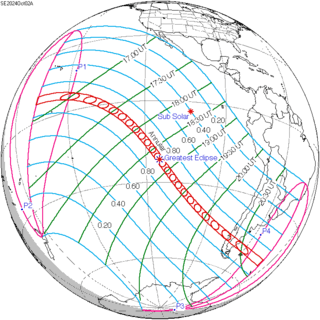 October 2, 2024 |
| 146 | 148 | 150 | 152 | 154 |
 July 22, 2028 |
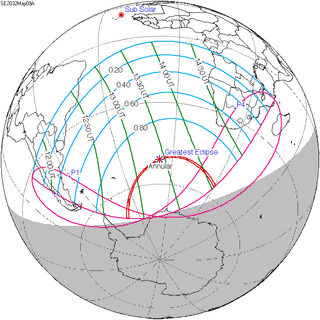 May 9, 2032 |
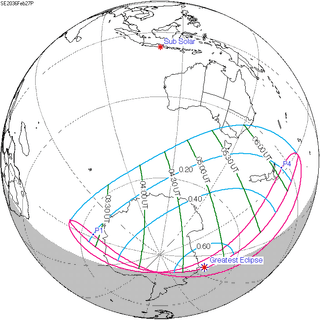 February 27, 2036 |
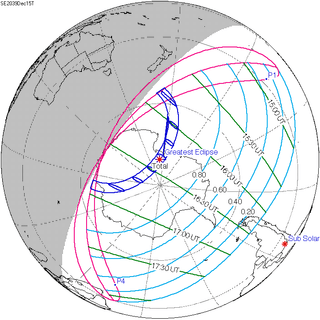 December 15, 2039 |
 October 3, 2043 |
| 156 | ||||
 July 22, 2047 | ||||
Notes
https://eclipse.gsfc.nasa.gov/SEgoogle/SEgoogle2001/SE2020Dec14Tgoogle.html
- van Gent, R.H. "Solar- and Lunar-Eclipse Predictions from Antiquity to the Present". A Catalogue of Eclipse Cycles. Utrecht University. Retrieved 6 October 2018.
- http://eclipse.gsfc.nasa.gov/SEsaros/SEsaros142.html
References
| Wikimedia Commons has media related to Solar eclipse of 2020 December 14. |
- Earth visibility chart and eclipse statistics Eclipse Predictions by Fred Espenak, NASA/GSFC
.jpg)
